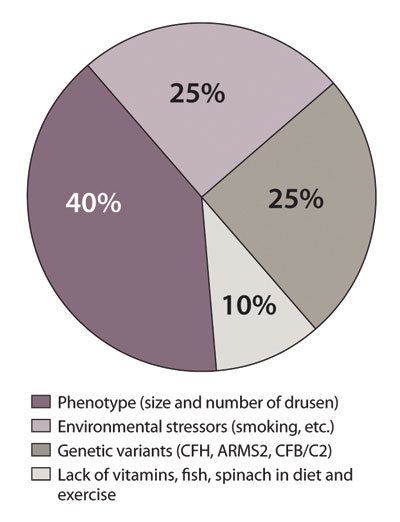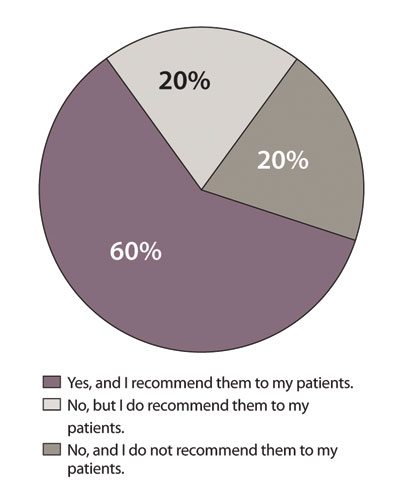The OSNE300 Survey
The OSNE300 Survey is a group of 300 European surgeons regularly polled for their opinions on hot topics in ophthalmology. The surveys are sent monthly, 10 times a year, to those on the list. If you do not receive the survey and would like to be included, please contact Managing Editor Erin L. Boyle at eboyle@slackinc.com.
What factors are most important in AMD risk assessment?
Our understanding of the genetics of AMD makes family history the first factor that I consider, and I am sure that in the future we will develop preventative treatments that will be tailored to the genetic risk. After that I consider the lifetime smoking history; It really is a shame that the role of smoking in increasing blindness of the elderly has not been given more prominence. Then the current retinal appearances should be considered, large soft drusen increasing risk as well as severe disease in one eye. Concurrent systemic disease and dietary history are also of interest. I do not regularly measure retinal lutein levels. Clearly there is a story for lutein being important, but I do not believe the scientific evidence is strong enough to introduce these measurements.
– Martin Harris, MD, FRCSEd, FRCOphth
Consultant ophthalmologist, Royal Free NHS Trust, London, England
Disclosure: Dr. Harris has received travel grants from Pfizer and Novartis and advised Bayer.

Do you believe that nutraceuticals and diet may prevent AMD?

Paolo Lanzetta
There is some evidence that antioxidant and supplement therapy may have a protective impact in the prevention and progression of AMD. However, some studies suggest that their effect may be minimal, and more than that, some forms of AMD may respond to supplement therapy and some others may not. Therefore, it is still difficult to assign the right patient to the right nutraceutical. Physicians may still exert an important role in society trying to prevent degenerative diseases such as AMD. They should work on recognized and modifiable risk factors by changing patients’ lifestyles. Cigarette smoking, unprotected exposure to sunlight and dietary habits are all well-known risk factors for the development and progression of AMD. The protective effect of the so-called Mediterranean diet has already been emphasized in cancer and cardiovascular conditions. Fish and olive oil consumption protect from breast, prostate and colorectal cancer, and wine has a protective effect on the risk of cardiovascular disease. Red meat consumption has been undoubtedly associated to colorectal cancer, and high fat intake leads to acute exposure to circulating endotoxins in diabetic subjects. It is in the interest of patients’ general and ocular health to enact a dramatic change in dietary and lifestyle habits.
– Paolo Lanzetta, MD
OSN Europe Edition Board Member
Disclosure: Dr. Lanzetta is a consultant for Alimera, Allergan, Bayer, Novartis and Roche and has a patent for Iridex.
There is incontrovertible evidence that antioxidant vitamins with copper and zinc salt decrease the risk of second eye involvement where there has been severe disease in one eye. This comes from the AREDS study. However, the results did not show a preventative benefit for earlier grades of AMD. Like many of my colleagues, I am awaiting the results of the AREDS II with interest, as we hope that we will have an answer to the question as to whether lutein supplementation helps to reduce risk of sight loss in AMD. Personally, I would be surprised if there was no effect, but until the results are released, I will continue to advise my patients that there could be a benefit and inform them of which foodstuffs have the highest levels of carotenoids.
– Martin Harris, MD, FRCSEd, FRCOphth
Consultant ophthalmologist, Royal Free NHS Trust, London, England
Disclosure: Dr. Harris has received travel grants from Pfizer and Novartis and advised Bayer.

Arthur Cummings
Some things to bear in mind concerning nutraceuticals are the following: The exact AREDS formulation is only really available in the U.S. and not really outside of the U.S. Secondly, the AREDS formulation is not a substitute for multivitamins. It is important to bear in mind that if patients are using multivitamins that contain some of the same constituents as the AREDS formulation, that they may in fact get too much of a specific ingredient, eg, vitamin E. High-dose supplementation of several of the AREDS constituents has lead to potential risks including an increased (albeit small) risk of lung cancer, prostate cancer and urinary tract infections with high doses of beta-carotene (smokers), vitamin E and zinc, respectively. The key message here is to ensure that patients are not getting any mega-doses of any constituent when combining the AREDS formulation with multivitamins.
– Arthur Cummings, MD, FRCS, and Eugene Ng, MD
Wellington Eye Clinic, Dublin, Ireland
Disclosures: Dr. Cummings and Dr. Ng have no relevant financial disclosures.



